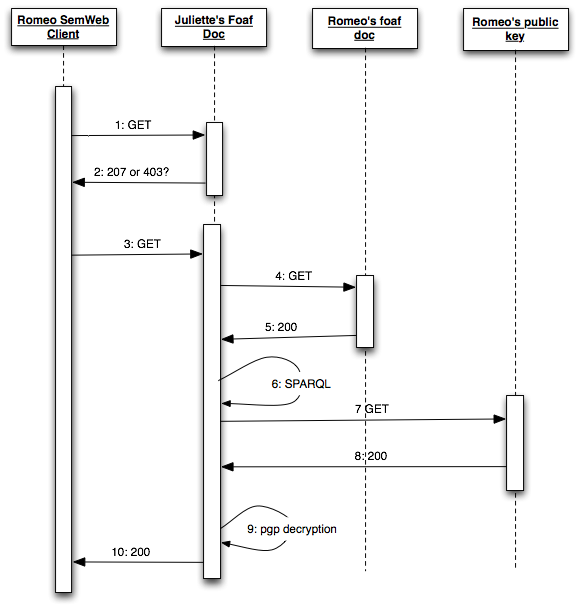- From: Story Henry <henry.story@bblfish.net>
- Date: Thu, 27 Mar 2008 13:06:52 +0100
- To: foaf-dev of a Friend <foaf-dev@lists.foaf-project.org>, Semantic Web <semantic-web@w3.org>
- Message-Id: <26D4ABDA-7CBE-4C40-B81B-DA7466DD5D5F@bblfish.net>
Hi, I would like to put the following forward as a sketch of what is needed to allow a resource to return different representations depending on the identity of the requester. We are looking for some security experts and others to help out here. There may be other standards that can be used, but it would help to see how far one can get with a very clean system to start off with. At least this should help understand what is needed. The idea is simple. We have 4 resources here. 1. A Semantic Web client owned by Romeo ( something like Beatnik, Tabulator or Knowee ) 2. Juliette's foaf file resource controlled by a slightly intelligent web service (one that knows to show which parts of the graph to show to whom) 3. Romeo's foaf file (perhaps also controlled by an intelligent web service, but there is no need for this here) 4. Romeo's public key. This could be part of the foaf file, but assuming that it does not change that often, it would be better placed at a separate resource in order to be more easily cacheable
So the sequence of calls I imagine are the following:
1. Romeo wants to have information about <http://juliette.org/
#juliette> (Juliette) so he GETs <http://juliette.org/>
2. the server responds with either:
- some minimal information and a yet to be invented return code of
207 PARTIAL INFORMATION
- a 403 Forbidden
In either case a header returning some information regarding the
type of authentication required is sent back
3. the client sends a GET back with some header information:
- the URL of Romeo <http://romeo.name/#romeo>
- an encrypted string (perhaps a string sent in the previous
response)
4. The server controlling Juliette's foaf doc sends a GET request to
the foaf file
5. The server controlling Romeo's foaf doc returns his foaf file, in
any number of formats, or perhaps even a GRDDLable document the server
can understand, containing a link to one of his public pgp keys
6. Juliet's server queries this representation transformed into
triples with the SPARQL query
PREFIX wot: <http://xmlns.com/wot/0.1/>
SELECT ?pgp
WHERE {
[] wot:identity <http://romeo.name/#romeo>;
wot:pubkeyAddress ?pgp .
}
7. Juliette uses the answer in 6 to GET the PGP key.
(what to do if someone has more that one PGP key?)
8. Romeo's server returns the PGP key
9. Juliette's server uses the public key to decrypt the string passed
in 3. Having done this Juliette's server now knows that the request in
3 came
from software owned by <http://romeo.name/#romeo>.
10. Juliette's server after consulting her policies for <http://romeo.name/#rome
>, returns the appropriate response; a 200 perhaps with a fuller
foaf file. Perhaps something else needs to be returned, a token to
give access to a number of resources (expressed in POWDER perhaps).
Now Romeo has more information about Juliette. Perhaps information
about where she they can meet.
This seems quite feasible.
Some thoughts that just arose from going through the exercise of
specifying each of the steps precisely:
- what kind of response should be returned in 2? Should this
redirect to an authentication server perhaps which would then return
some token to give access to all the resources in a domain?
- What about multiple pgp keys?
- others?
Does this help?
Henry
Home page: http://bblfish.net/
Attachments
- image/png attachment: SequenceDiagram.png

- application/pkcs7-signature attachment: smime.p7s
Received on Thursday, 27 March 2008 12:07:50 UTC